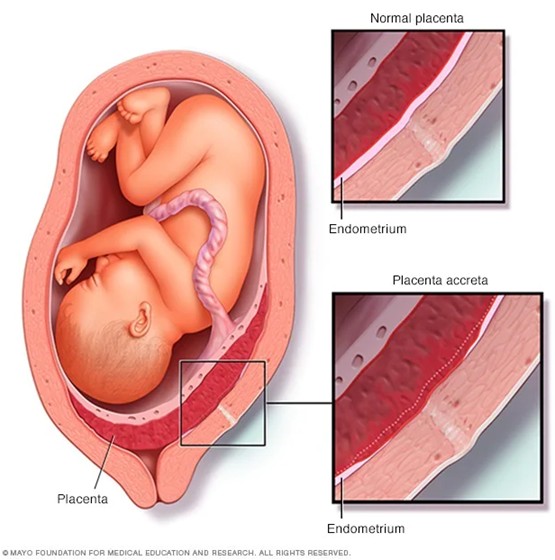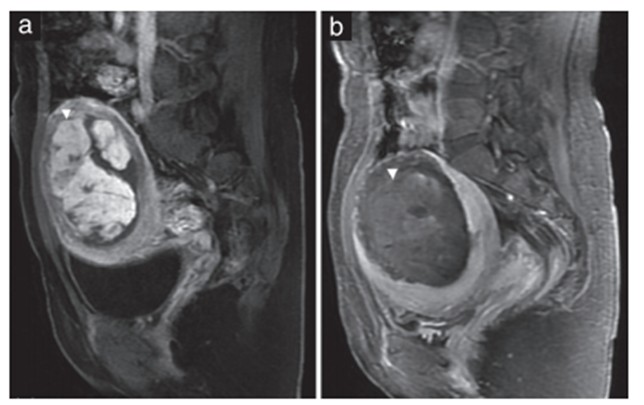About

Placenta accreta is a serious pregnancy condition that occurs when the placenta grows too deeply into the uterine wall. Typically, the placenta detaches from the uterine wall after childbirth. With placenta accreta, part or all of the placenta remains attached. This can cause severe blood loss after delivery.
It's also possible for the placenta to invade the muscles of the uterus (placenta increta) or grow through the uterine wall (placenta percreta). Placenta accreta is considered a high-risk pregnancy complication.
Current Treatment Methods
Planned cesarean hysterectomy is the preferred treatment for placenta accreta. For patients who desire to preserve their fertility, conservative treatment such as uterine artery embolization (UAE) and high intensity focused ultrasound (HIFU) should always be the standard. UAE is effective for preventing postpartum hemorrhaging caused by PAS disorders. HIFU is a non-invasive treatment technique which is feasible and effective for placenta accreta after vaginal delivery and without active vaginal bleeding.
Jiang J, Wang C, Xue M. High-intensity focused ultrasound versus uterine artery embolization for patients with retained placenta accreta. Eur J Obstet Gynecol Reprod Biol. 2020 Sep;252:82-86. doi: 10.1016/j.ejogrb.2020.06.003. Epub 2020 Jun 8. PMID: 32590166.
What are the benefits of HIFU?
◼ It is non invasive, which means faster recovery comparing to surgery
◼ Only sedation, no anesthesia required
◼ Precise ablation without damaging the surrounding myometrium
◼ Lower treatment risks
Am I suitable to undergo HIFU?
Suitable Indications:
◼ Diagnosis was confirmed;
◼ Patients agreed to have pre-HIFU and post-HIFU MRI evaluation
◼ Patients could communicate with physicians during the procedure of HIFU treatment
◼ Stable vital signs without active vaginal bleeding or infection, and normal liver and renal function
◼ Desire to preserve fertility and to breast feed, and declining surgery and chemical therapy
*Please be noted the above criteria is only for reference, whether a patient can be applied HIFU shall be further confirmed by HIFU doctors after diagnosis.
Contraindications:
◼ Lesion could not be visualized
◼ Patients undergoing pregnancy or lactation
◼ Patients with suspected or confirmed uterine malignant diseases
◼ Uncontrolled pelvic inflammatory diseases
◼ Significant vaginal bleeding
◼ Abnormal or unstable vital signs
Effectiveness of HIFU
Symptom Relief
In recent years, HIFU has been proposed as a non-invasive treatment that could preserve the uterus in women with placenta accreta, with many studies proving its safety and effectiveness. For example, according to a study evaluating the effectiveness of single HIFU ablation in managing placenta accreta spectrum (PAS) disorder, 37 (92.50%) patients recovered without complications or further treatment, while 18 (45.00%) patients had the placenta tissues evacuated during the follow-up period.
Another study of the management of placenta accrete after vaginal delivery has shown that compared with values at ultrasound imaging before treatment, all patients the vascular index of the residual placenta had decreased substantially and the residual placental volumes had decreased (average decrease, 7.7 cm3) after HIFU treatment. Reduced signal intensity and degree of enhancement on MRI were also observed in all patients.
Fertility Outcome
Studies postulate that HIFU is advantageous in improving fertility because it does not cause damage to the uterus and ovarian function. Patients returned to normal menstruation rapidly after HIFU and planned pregnancy three months after the menstrual recovery. In a study, Among the
18 patients with planceta accrete who received HIFU and expressed future reproductive plans, no reduced menstrual volume cases were reported, eleven were temporarily on contraceptives, and the remaining seven became pregnant during the follow-up period (15.75–44.00 months; median 30.50 months). All pregnancies were not complicated by any placental abnormalities.
1. Yuan Y, He X, Liu P, Pu D, Shi Q, Chen J, Teichmann AT, Zhan P. The effectiveness of single ultrasound-guided high-intensity focused ultrasound (USgHIFU) ablation in managing placenta accreta spectrum (PAS) disorder. Arch Gynecol Obstet. 2022 Dec 16. doi: 10.1007/s00404-022-06840-6. Epub ahead of print. PMID: 36525091.
2.. Bai Y, Luo X, Li Q, Yin N, Fu X, Zhang H, Qi H. High-intensity focused ultrasound treatment of placenta accreta after vaginal delivery: a preliminary study. Ultrasound Obstet Gynecol. 2016 Apr;47(4):492-8. doi: 10.1002/uog.14867. Epub 2016 Mar 6. PMID: 25846712.
Safety of HIFU
Complications related to HIFU treatment include inaccurate targeting, skin burns, injuries to the bowel and nerves, pelvic pain and distension and radiating pain into the lower limbs. However, many studies has reported no severe complications occurred after the management of placenta accreta, only a few cases reported slight pain, which disappeared soon after the treatment.
Bai Y, Luo X, Li Q, Yin N, Fu X, Zhang H, Qi H. High-intensity focused ultrasound treatment of placenta accreta after vaginal delivery: a preliminary study. Ultrasound Obstet Gynecol. 2016 Apr;47(4):492-8. doi: 10.1002/uog.14867. Epub 2016 Mar 6. PMID: 25846712.
Case Study

Contrast-enhanced T1-weighted magnetic resonance imaging in a patient with placenta accreta undergoing treatment with high-intensity focused ultrasound.
(a) Before treatment the lobulated and heterogeneous residual placenta is clearly enhanced (arrowhead)
(b) 1 day after treatment, residual placenta (arrowhead) has decreased in size and changed, becoming homogeneous with low signal intensity and with complete absenceof enhancement.
Bai Y, Luo X, Li Q, Yin N, Fu X, Zhang H, Qi H. High-intensity focused ultrasound treatment of placenta accreta after vaginal delivery: a preliminary study. Ultrasound Obstet Gynecol. 2016 Apr;47(4):492-8. doi: 10.1002/uog.14867. Epub 2016 Mar 6. PMID: 25846712.